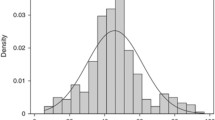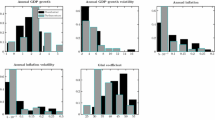6. Conclusions
We have estimated two models explaining political support for the president as a function of economic performance. One model reflects the assumption characterizing most of the literature, that voters indiscriminately punish inflation and unemployment without regard to the tradeoffs between them. The other represents a more demanding conception of voter sophistication about macroeconomic possibilities and about control of the money supply. While the data do not unambiguously designate a ‘best’ model of behavior, the sophisticated voter hypothesis performs as well as the naive voter hypothesis in the context of our study. Clearly this result is subject to the usual econometric caveats including possible misspecification of the model, multicollinearity among independent variables, etc.. However, there is no particular reason to believe that these problems should favor one model as opposed to the other. Thus, while we cannot conclude that voters really think in terms of rates of growth of velocity and natural output, we can question the conventional wisdom that consistent rule-based monetary policies may not be politically viable.
Our findings are somewhat reassuring in suggesting that the electoral process does not inevitably involve adverse incentives, as the political business cycle literature suggests that it does. However, the fact that the conventional naive voter model performs comparably well does illustrate that questions about the nature of electoral incentives in economic policy are far from resolved. Our claim is not to have provided a better explanation for patterns of political support, but rather to have conceptualized and tested an alternative to models which suggest that voters are vulnerable to cynical manipulation.
Similar content being viewed by others
References
Abrams, R.K., Froyen, R.T., and Waud, R.N. (1980). Monetary policy reaction functions, consistent expectations and the Burns era. Journal of Money, Credit and Banking 12 (Feb.): 30–42.
Anderson, L.C., and Jordan, J.L. (1968). Monetary and fiscal actions: A test of their relative importance in economic stabilization. Federal Reserve Bank of St. Louis Review 50 (Nov.): 11–24.
Beck, N. (1982a). Does there exist a political business cycle: A Box-Tiao analysis. Public Choice 38: 205–209.
Beck, N. (1982b). Presidential influence on the federal reserve in the 1970s. American Journal of Political Science 26 (Aug.): 415–45.
Carlson, K.M. (1982). The mix of monetary and fiscal policies: Conventional wisdom vs. empirical reality. Federal Reserve Bank of St. Louis Review 64 (Oct.): 7–21.
Chappell, H.W., Jr. (1983). Presidential popularity and macroeconomic performance: Are voters really so naive? Review of Economics and Statistics (Aug.): 385–392.
Chappell, H.W., Jr., and Keech, W.R. (1983). Welfare consequences of the six-year presidential term evaluated in the context of a model of the U.S. economy. American Political Science Review 77 (March): 75–91.
Fair, R.C. (1978). The effect of economic events on votes for president. Review of Economics and Statistics 60 (May): 159–173.
Frey, B.S., and Schneider, F. (1978). An empirical study of politico-economic interaction in the United States. Review of Economics and Statistics 60 (May): 174–183.
Golden, D.G., and Poterba, J.M. (1980). The price of popularity: The political business cycle reexamined. American Journal of Political Science 24 (Nov.): 696–714.
Gordon, R.J. (1981). Macroeconomics, 2nd ed. Boston: Little, Brown.
Hibbs, D.A., Jr. (1982). The dynamics of political support for American presidents among occupational and partisan groups. American Journal of Political Science 26 (May): 312–332.
Kernell, S. (1978). Explaining presidential popularity. American Political Science Review 72 (June): 506–522.
Kramer, G.H. (1971). Short-term fluctuations in U.S. voting behavior, 1896–1964. American Political Science Review 65 (March): 131–143.
MacRae, C.D. (1977). A political model of the business cycle. Journal of Political Economy 85 (Apr.): 239–263.
Maisel, S.J. (1973). Managing the dollar. New York: Norton.
Maloney, K.J., and Smirlock, M.L. (1981). Business cycles and the political process. Southern Economic Journal 48 (Oct.): 377–392.
McCallum, B.T. (1980). Rational expectations and macroeconomic stabilization policy: an overview. Journal of Money, Credit and Banking 12 (Nov.): 716–746.
McCallum, B.T. (1978). The political business cycle: An empirical test. Southern Economic Journal 44 (Jan.): 504–515.
Meltzer, A.H., and Vellrath, M. (1975). The effects of economic policies on votes for the presidency: Some evidence from recent elections. Journal of Law and Economics 18 (Dec.): 781–798.
Mishkin, F.S. (1982). Does anticipated monetary policy matter? An econometric investigation. Journal of Political Economy 90 (Feb.): 22–51.
Monroe, K.R. (1983). Political manipulation of the economy: A closer look at political business cycles. Presidential studies quarterly 13 (Winter): 37–49.
Nordhaus, W.D. (1975). The political business cycle. Review of Economic Studies 42 (Apr.): 169–190.
Sims, C.A. (1972). Money, income and causality. American Economic Review 62 (Sep.): 540–552.
Thompson, W.R., and Zuk, G. (1983). American elections and the international electoral-economic cycle: A test of the Tufte Hypothesis. American Journal of Political Science 27 (Aug.): 464–484.
Tufte, E.R. (1978). Political control of the economy. New Haven: Yale University Press.
Winters, R.F., et al. (1981). Political behavior and American public policy: The case of the political business cycle. In S. Long (Ed.), The handbook of political behavior, Vol. 5, 39–111. New York: Plenum Press.
Author information
Authors and Affiliations
Additional information
We acknowledge the support of National Science Foundation Grants SES-8217987 and SES-8218421, and the useful comments and suggestions of Nathaniel Beck, Kenneth Koford and of the macroeconomics seminar at U.N.C.
Rights and permissions
About this article
Cite this article
Chappell, H.W., Keech, W.R. The political viability of rule-based monetary policy. Public Choice 46, 125–140 (1985). https://doi.org/10.1007/BF00179735
Issue Date:
DOI: https://doi.org/10.1007/BF00179735




